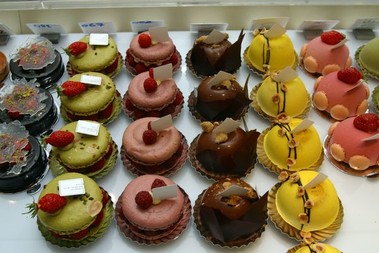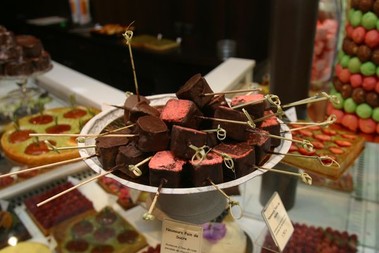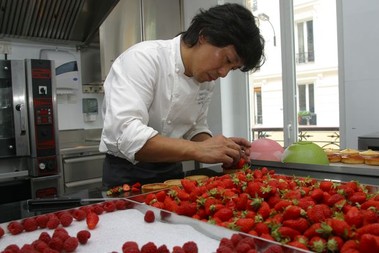Breaking the mold - some patisseries move the classics to a back burner
February 18, 2007 - The Boston Globe - Travel Section

PARIS—France has earned a reputation as a culinary mecca by mixing centuries of tradition with innovation. But the French can also be incredibly stodgy when it comes to food. Nowhere is that more in evidence than with pastry.
Walk in to a good French patisserie and not only will you find it museum-like in its beauty, you will also find that the recipes for the pastries could have been created by Auguste Escoffier himself.
But don’t despair.
In Paris, a tiny handful of classically trained pastry chefs are breaking the molds and reaping the benefits. The French may be slow to accept change, but they know a good thing once they have it in their mouths.
“People have a need for a few benchmarks—they need their ‘Big Five,’ ” says Didier Mathray, who runs the far-from-standard Pain de Sucre pastry shop with his partner, Nathalie Robert. Mathray begins reeling off a list of classic creations like mille-feuille and lemon tarts before seemingly getting bored with the exercise.
Then he grins. “But the people who buy the classics also buy creative stuff.”
 Rosewater marshmallows at the Pain de Sucre shop.(Photo by Joe Ray for the Boston globe)
Rosewater marshmallows at the Pain de Sucre shop.(Photo by Joe Ray for the Boston globe)After years working as pastry chefs for the avant-garde French chef Pierre Gagnaire, the couple’s push to escape from the ordinary at Pain de Sucre can reveal extraordinary results. It’s also a challenge their customers have learned to relish.
One of their hallmarks has become an ever-changing array of layered desserts in glasses. Their most popular, the obscurely named “Mr. Tom,” combines layers of green apple mixed with coriander, Campari gel, orange, and red fruit crumble.
Robert has also come up with a set of cubes that she says are designed for snacking that combine ingredients such as mint, marshmallow, and saffron, all coated in chocolate.
Laugh at Robert’s use of marshmallows at your own expense. At Pain de Sucre, what might otherwise be met with a chuckle is turned into a specialty with flavors like chocolate, rosewater, hot pepper, or saffron.
“People are looking for something from their childhood,” says Robert. It sounds like a classic French cliché until she offers up a new version of a traditional French almond-paste delicacy called a “calisson.” This one is revved-up with candied oranges and orange tree flower. Along with the almond and orange flavors there is something else. I close my eyes in the middle of the room to focus on it—and realize it’s a memory from my mother’s kitchen. Suddenly, I understand exactly what she’s talking about.
“You’ve got to take the risk to shock the client,” adds Mathray, trying to explain how they go about seeking the unexpected and intangible.
So why don’t more pastry chefs follow suit?
“It’s easy to reproduce what you know,” he adds. “It’s very French. You know you’re going to sell X boxes [of a classic], but it’s more interesting to take a risk.”
Echoes of this theory are easy to hear across town at the Aurore-Capucine pastry shop run by Jean-François and Marie-Odile Petit.
“Every day is different, and doing the same stuff all the time doesn’t interest me,” says Jean-François. “When we arrive in the morning and open the front grate, it’s like a curtain going up at the theater.”
The Petits’ theater is fittingly beautiful for the delicacies it contains. A former wine cellar turned pastry shop, and then the home of what Jean-François calls an “uninteresting boutique,” the place seems to have finally found true calling with the couple’s quirky offerings at center stage.
It didn’t happen overnight. “The French are pretty closed,” says Jean-François, “but little by little, we won them over.”
 At Sadaharu Aoki’s shops eclairs may be green and croissants filled with red bean paste.(Photo by Joe Ray for the Boston Globe)
At Sadaharu Aoki’s shops eclairs may be green and croissants filled with red bean paste.(Photo by Joe Ray for the Boston Globe)Asked about their specialties, you quickly discover the list is nearly all-inclusive. They have sweet and savory shortbread cookies, along with a chocolate-violet tart, multi colored macaroons from a recipe that dates from Louis XIV’s time and something called a “marriage de velouté” (a velvety pairing ) that combines raspberries and mango with almond paste, rose meringue, and fresh flowers (“capucine” being French for “nasturtium”).
“They’re beautiful to look at and they are very refined,” says Marie-Odile. She’s not kidding—with flowers as a near-staple in the creations at Aurore-Capucine, there is a constant blend of the exotic and the romantic. Any Frenchman who finds himself in the doghouse with his significant other would be well-served to bring one of these creations home.
“We try to do as much as possible and surprise up to the end,” she adds.
Keeping their pastries unique is a very conscious decision. Asked if he would be interested in returning to the classic style in which he was trained at the famous Fauchon bakery, Jean-François’ eyes glaze over with a faraway look like the one on Mathray’s face when he tried getting through the “Big Five.”
“Nope,” he says. “Not interested.”
It’s also something their clients wouldn’t tolerate.
“People notice when something [we’ve been making] disappears,” he says.
But even the Petits still marvel about their customers’ reactions.
“They’re like little kids and they seem to have an extra courtesy between them when they come in the shop,” says Marie-Odile. “This isn’t like a classic pastry shop or a trendy one . People come in here and they talk to one another—that’s kind of rare.”
Parisian clients have even been known to help a baker or two find their wings.
“In the beginning, I had a very normal [ read “classic French” ] style, but some Frenchmen were wondering why I wasn’t adding something more Japanese to the mix,” says baker Sadaharu Aoki, a native of Japan who runs three eponymous pastry shops in town and two in Tokyo.
After his motocross career ended with a crash that injured his back, Aoki spent two years studying French pastry styles in Japan followed by eight more years studying in France before opening his first store in Paris.
Downing Diet Cokes while sitting in his office, where shoes are banned and house music pumps from a sleek sound system, Aoki explains that it took 2 1/2 years to hit his stride, blending French classics with Asian flair. Now, in pastry circles, he is even referred to simply as Sada—a one-word moniker à la Sting or Madonna.
“I thought Japan was too small for me,” he says, smiling. Even here in the Asian community of Paris, he sees himself as “the weird one.”
Weird or not, he understood what Parisians wanted from him. “When you go to a sushi place, you want the chefs to be Japanese,” he says. Aoki’s quirky extrapolation of this meant the French wanted a bit of Asian flair from their Japanese baker.
The difference is evident as soon as you walk into his stylish stores, where éclairs and other pastries are turned green with matcha tea, and croissants are sometimes filled with red bean paste.
“Being a chef at a pastry shop is a job that can be very similar from place to place,” he says. “There’s an ‘untouchability’ to French pastries, but the Parisians leave the door open just a bit.” Clearly, he is glad he has found his way past the barrier. “I want to show the Parisians everything I can do.”
Aoki could be speaking for his fellow pastry makers when he says: “Now I don’t care what the other chefs are doing. I’m looking for something special.”
Contact Joe Ray, a food and travel writer based in Europe, through his website: www.joe-ray.com.
If you go…
Aurore-Capucine
3 rue de Rochechouart
011-331-487-81620
“Tartelettes,” mini fruit tarts, about $5.
Pain de Sucre
14 rue Rambuteau
011-331-457-46892
Marshmallows about $1, “Mr. Tom” and other layered desserts about $5.80.
Sadaharu Aoki
56, boulevard Port Royal
011-331-453-53680
sadaharuaoki.com
Éclair with matcha tea, about $5.50.